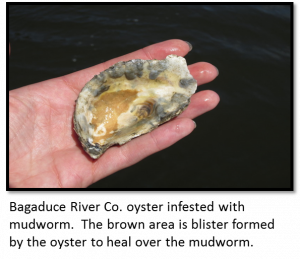Managing an Oyster Parasite
A Maine Oyster Farm tests methods for reducing the infestation of Polydora websteri. in Eastern Oysters
SARE GRANT FNE09-663
Written by Erin Roche, UMaine Graduate Student
According to Jesse Leach, you should eat your first oyster “Naked. Nothing on it, otherwise you won’t get the flavors of that area….” Leach and his partner, Eric Moran, have been growing oysters for over 10 years on their 4.3-acre stretch of the Bagaduce River. Tasting the briny sweetness of the river as we sip oysters, Leach unfolds the story of a tiny worm that appeared three years ago on his farm and is damaging his crop of eastern oysters, Crassostrea virginica. The presence of the mud blister worm, Polydora sp., is a worldwide nuisance for oyster farmers. The worm stresses the oyster by boring a mud-lined burrow into its shell. In effort to quarantine the worm, the oyster “blisters” over the parasite with new shell, overall weakening the shell and giving it a dark discoloration. Such damage reduces the market value of the oyster and  poses a serious financial loss to the farmer.
poses a serious financial loss to the farmer.
Aboard the boat, we visit the upweller Leach crafted to house the nascent oysters as they grow. Next, we see the surface floating baskets housing oysters during the “grow out” period until maturity and harvest. “Yankee ingenuity” is apparent throughout Leach’s oyster empire, however, the mud blister worm stands largely in the way of him raising a pristine product. Previous research to control the mudworm has yielded unclear results, yet some value has been found with air-drying oyster baskets and also submerging them in brine dips. To investigate these methods further and respond to the increasing pressure for a solution, Leach partnered with Dana Morse from University of Maine’s Darling Marine Center and applied for a SARE grant. Leach and Morse used previous research as a launching pad to devise an experiment to test worm predatation by urchins, as well as different equipment types under various intensities air-drying and salt brining.
The SARE Project
In an effort to reduce the presence of mud blister worm, Leach was awarded a 2-year, $9,365 SARE grant in 2008. The grant covered equipment investments and the costs of conducting the treatments and data collection. Stocking each cage unit (see Final Report for cage descriptions) with 2 gallons of fresh oyster seed in the summer of 2009, Leach conducted his evaluation of the following 5 treatments under the assumption that prolonged air-drying, brining, and iodine would increase worm mortality and burrows.
- Cage Flipping of Oyster bags and Oyster-Gro units for 24 hours, once a week. Through flipping, the unit air-dries.
- Salt Brining (saturated salt) of Oyster bags, Oyster-Gro cages, Dark Sea Racks and bottom racks, once a month. Oyster bags are dipped in seawater and saline solution for (5,10, or 15 minutes), then air-dried.
- Iodine submersion of Oyster bags, Oyster-Gro, and bottom racks once a month. Oysters and cages are dipped into iodine solution, then air dried.
- Green Sea Urchins (Strongylocentrotus droebachiensis) Urchins grown in oyster cages may prey on worm larvae.
- Adjustable Longlines. These allow for regular air-drying of floating bags based on tidal cycle.
All treatments were accompanied by a control that received normal management. Data collection on initial size, final size, and growth was conducted three times per year for two years by sampling 30 random oysters from each experiment. First year sampling also included a worm burrow count in shells. At the close of the trial, the team collected the number of burrows and sizes of oysters under each treatment.
The Results
As is the case in farming, some unexpected events occurred in executing the experiment. Contingent on receiving a permit for a new site, Leach was unable to conduct the iodine and adjustable longline treatments. Furthermore, all of the urchins died before they could be placed in the oyster cages. Obstacles aside, the data yielded some conclusive results. The team found that the control groups experienced significantly higher worm infestation compared to all of the other treatments. While all treatments generally reduced worm infestation, infestation levels remained precariously high and Leach found the oysters still unmarketable.
Summary
The trials tested under the SARE grant provided some reduction in worm infestation, though worm damage was still too high to market the oysters. The findings of this research triggered a momentous study through University of Maine’s Darling Marine Center and the Center for Cooperative Aquaculture Research (CCAR) in Franklin Maine. At CCAR, researchers put infested oysters in a moist air storage refrigerator unit of 38 degrees F. After three weeks of storage, they found promising results with nearly 100% worm mortality. Currently, Bagaduce River Co. implements a multi-season winter refrigeration regime into its operation and is finding substantial improvements in the infestation rate of their oysters. Leach attributes the SARE grant and partnership with Morse as stimulus for solving the blister worm infestation.
For more information, see the SARE Project Overview and Reports.
